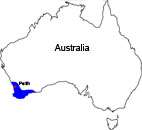Western pygmy perch
| Western pygmy perch | |
|---|---|
 | |
| Photo by Jim Owens Male, showing breeding colors | |
 | |
| Photo by Jim Owens Female, showing breeding colors | |
| Not evaluated (IUCN 3.1) | |
| Scientific classification | |
| Kingdom: | Animalia |
| Phylum: | Chordata |
| Class: | Actinopterygii |
| Order: | Perciformes |
| Family: | Percichthyidae |
| Genus: | Nannoperca |
| Species: | N. vittata |
| Binomial name | |
| Nannoperca vittata (Castelnau, 1873) | |
| Synonyms | |
| |
The western pygmy perch (Nannoperca vittata) is a species of temperate perch endemic to southwest Australia. A relatively small fish, it can reach 8 cm (3.1 in) TL.[1]
Reproduction
Pygmy perch are egg layers. They produce eggs singly, laying 12 to 15 over a period of up to three hours.
During the breeding season (July to November), both sexes become noticeably more colorful. Most of the male’s fins (except for the pectoral) become black, and its sides have an orange tinge on the lower and upper body. The upper portions of the female’s sides become bluish.
The eggs measure around 1.2 mm and are slightly adhesive, which allows them to cling to submerged plants, rocks, or debris. Spawning usually occurs in the latter part of the morning.
Hatching occurs after around three days from laying. The 3-mm larvae look quite different from juveniles of the species and have no mouth for several days, but are recognizably perch-like after around 27 to 30 days.
Western pygmy perch larva
Environment
They are found predominantly in lakes, streams, and swamps, and can withstand a degree of brackishness. They have a preference for living among vegetation in the shallows around the water perimeter, and acclimatize readily to a range of water temperatures from almost 0 to 25°C.

Diet
Mainly carnivorous, they eat various dipteran larvae, including mosquitos, ostracods, and copepods, and small quantities of algae, and are adept at taking mosquitoes from the surface of the water.
Uses
Pygmy perch may be safely kept in an aquarium along with tropical fish. They are considered safe with tadpoles, so are used in frog ponds to control mosquito larvae.
References
- ↑ Froese, Rainer and Pauly, Daniel, eds. (2014). "Nannoperca vittata" in FishBase. February 2014 version.